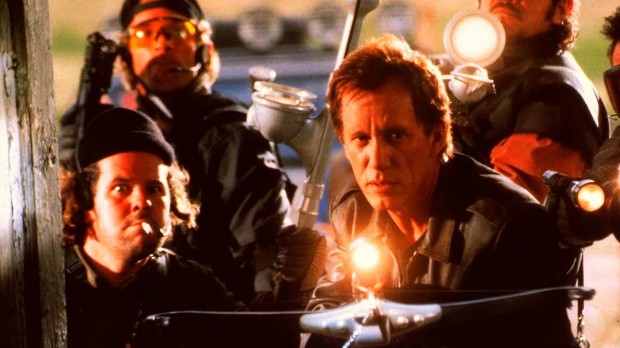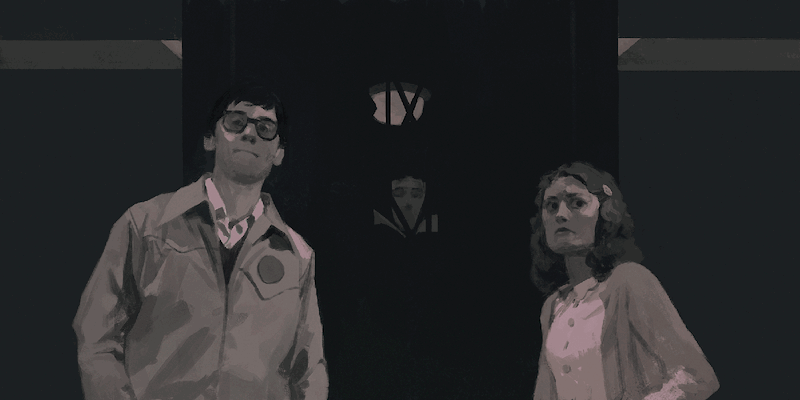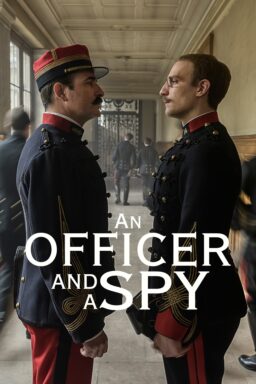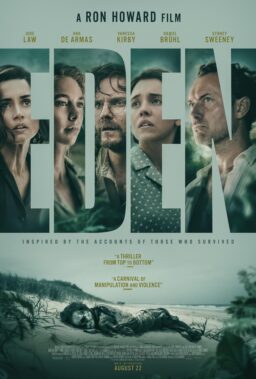1.
“Nighthawks at the Cinema“: Keith Phipps explores midnight movies at The Verge.
“First released in September of 1975, ‘Rocky Horror’ has never left theaters, and the film is more famous now than ever. But fame has also changed it, turning it from a fringe item to an institution famous enough to provide fodder for an episode of ‘Glee’ and a possible TV remake for Fox. And as it’s grown in fame, the cult has appeared to lose some of its outsider fervor over the years, with weekly gatherings like this one becoming increasingly less common across the country. You wouldn’t know that sitting in the Art Theatre in Hobart, though. Each week the cast and crowd goes through a ritual familiar to anyone who’s seen ‘Rocky Horror’ at a midnight show: A pre-show featuring clips involving the ‘Rocky Horror’ cast and other bits of weirdness. A ‘virgin auction’ in which first-time attendees are subjected to good-natured, if obscene, initiation rituals. And then the show itself, in which the venerable movie plays out behind a live-action reenactment — known in ‘Rocky’ fandom as a ‘shadow cast’ — as its dialogue gets interrupted by a mix of crude, witty retorts from the audience, some nearly as old as the film itself. That also makes them older than most of the attendees — who skew toward teens and 20-somethings. ‘I was always very socially awkward. Never felt like I fit in anywhere,’ a man who asks to be identified only as T.R. tells me in the Art Theatre lobby a few hours before the show. These are odd sentiments to hear from a handsome 31-year-old union plumber wearing a Captain America T-shirt, with a physique and unerring gaze to match, but there’s not a hint of insincerity to them. ‘I did sports, I did theater, I did a bunch of stuff and never fit in.’”
2.

“Rebecca Parrish on ‘Radical Grace’“: The director chats with Indie Outlook about her documentary, winner of the Chicago Award at this year’s Chicago International Film Festival, which opens for a week-long run at the Gene Siskel Film Center Friday, November 6th.
“Pope Francis is very progressive and is saying exciting things on a lot of fronts about economic justice and environmental justice. He’s definitely not as shut down as Pope Benedict was, and there’s not the culture of fear that there used to be in the church. On the other hand, he still believes that women cannot be priests and he sees a more traditional gender role for women, so this film’s message is still as relevant as ever. Pope Francis is like, ‘Hate the sin, love the sinner,’ while Pope Benedict preached, ‘Hate the sin and the sinner.’ [laughs] There’s a national organization based in Chicago called Call To Action that does social justice work and organizes Catholics to challenge injustices in the church. They’re partnering with the film, and one of the things that we’ve been talking about with them is how can we leverage the film for some of their campaigns. We’ve discussed issues of women’s inequality in the church, as well as the recent firings of church workers. These people are tied to a certain ministry of the church, work at a food pantry associated with the church or work at a Catholic school, and they are being fired because they are gay and have married their partner. People may have known about their partner, but the fact that they’ve made the relationship official and public is unacceptable, since it goes against church teaching. That’s the argument, and it’s happening all over the country. It’s the new wave of discrimination spurred by the legalization of gay marriage. The same sort of persecution is happening to the sisters, just in a different part of the church. The reason why the church hierarchy came down on the nuns was because they’re something that they can target. They can’t tell everyday Catholics what to do, but they can target a specific group and bring disciplinary action against them.”
3.

“Why is her suicide somehow harder on us than his death by machete?“: A great piece from Jim Schutze of The Dallas Observer.
“File under mysteries of the soul: that the suicide of the widow is somehow heavier to bear than the savage random murder of her husband. And then again, that’s nonsense. Who are we, strangers, to assign weight or relative value to the death of Patti Stevens, who committed carbon monoxide suicide in her garage last Sunday, October 25, or to the death of her husband, Dave Stevens, hacked to death while jogging near White Rock Lake by a machete-wielding, vision-seeing, voice-hearing stranger on October 12?Death is death. Is there anything more to say?I should know better than to put my hand up, but I think the answer may be yes. There is a little more to say. Not a lot. But something. I have some odd experience in this area, having written more newspaper stories and books about murder than I ever really wanted to.But, no, I don’t know anything about the inner nature of murder itself, if it has an inner nature. No more than you do, no more than any of us. What I think I know a little about is the effect murder has on other people, on survivors, the loved ones of the victims, the loved ones of the murderers, for that matter, on those of us who are total strangers reading about it or seeing it in the news.”
4.

“‘I’m a Cheap Guy’: John Carpenter on ‘Vampires’“: In conversation with Jim Hemphill at Filmmaker Magazine.
“Filmmaker: ‘The casting of James Woods as the hero is interesting in that regard. He’s not somebody you usually think of as playing that kind of conventional leading man role.’ Carpenter: ‘That’s exactly why I cast him; I thought, ‘We haven’t seen this.’ You know, when you’re casting you really just make a general guess as to how it’s going to go. I figured the audience might enjoy it since they weren’t used to seeing him as an action hero.’ Filmmaker: ‘He’s very, very funny in the film. There are a lot of great acidic one-liners that he really pulls off.’ Carpenter: ‘He made a lot of that stuff up on set. Once I got a take with the dialogue as written, I would let the actors riff away. You sort of have to with Woods – that’s just who he is, and you either go with it or you don’t. He’s a challenging guy, and some of what he comes up with is good and some of it’s bad, but I had a good time with him.’ Filmmaker: ‘Do you have a particular approach when it comes to directing actors that you find gets the most out of them?’ Carpenter: ‘You just have to figure out what each actor needs. Most of them want a father, and you have to determine as you’re working with them if they respond best to a strong father, a nice father, a severe father – what’s going to get the best out of them? Sometimes you have a group of actors who each need different approaches, and it’s tough to know what to do in that situation; you just do the best you can. It’s an exhausting job, I must tell you.’”
5.

“‘Sicario”s Dirty War on Mexican Cartels Is Not Yet Reality“: At Pacific Standard, veteran border correspondent Sebastian Rotella offers his take on Denis Villeneuve’s acclaimed film.
“Overall, I found ‘Sicario’ artful and thought-provoking. The focus is intentionally narrow: Villeneuve portrays a battleground obscured by a permanent fog of war. The film succeeds in evoking the menace, paranoia, and ambiguity of the turf. ‘Sicario’ falls short for me in other aspects. While it has impeccably realistic moments, the federal agents broke the rules with a casualness (and lack of consequences) unlike anything I’ve reported on. I also would have liked more depth in the depiction of the Mexican side, though there’s a limit to what can be done in two hours. The first thing I look for in a drama like this is the authenticity of the characters—how they compare to the swashbuckling and ferocious ones I’ve met. Josh Brolin is convincing as the chief of the task force, a brash spy who drops enigmatic lines about his plan to ‘dramatically overreact’ against the cartel that has murdered dozens of people on the U.S. side of the border. Benicio Del Toro’s role as the brooding, relentless sicario is the best thing about the film. An early scene in which he shudders awake from a nap establishes him as a man who has nightmares—and inflicts them on others. The FBI agent played by Emily Blunt is refreshingly unglamorous. Her clashes with the CIA/Pentagon crew have a real-life basis in conflicts among U.S. agencies. Her mystified indignation becomes less credible, however, as she continues to tag along with the marauding unit. The lack of Hispanic characters on the U.S. law enforcement team surprised me. This is not an abstract issue of diversity in Hollywood; traveling the borderlands, you meet many sharp Hispanic federal agents making the most of their language and cultural skills.”
Image of the Day

“Chris Brown’s ‘Zero’ Artwork Sure Looks Familiar” points out Kotaku‘s Brian Ashcraft.
Video of the Day
38 years ago, in our very own galaxy, six actors posed for their final close-up in a film that went on to change their industry—and audience expectations—forever. If you had told them back then that they would all be reprising their roles in 2015, they would’ve dismissed such predictions as pure fantasy.












